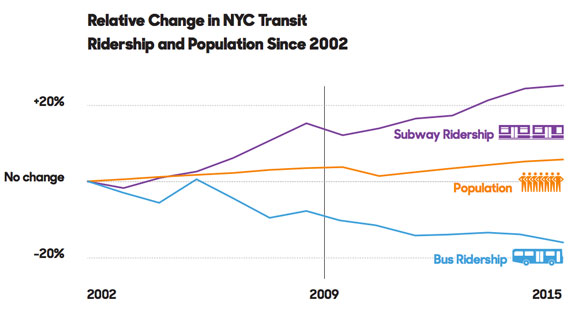
Bus service in New York is getting worse and losing riders, and unless policy makers step in and make systemwide improvements, those trends may accelerate in a vicious cycle. New York can turn things around, advocates say, with a suite of policies to get buses moving quickly and reliably again.
Today a coalition of transit advocates unveiled their blueprint to fix the city's surface transit system and win riders back over. The solutions they propose in "Turnaround: Fixing New York City's Buses," a new report from TransitCenter, are broad and thorough but eminently achievable -- rethinking the bus network, modernizing fare technology and dispatching, and expanding street design features that have already sped service on a handful of routes to improve routes all over the city.
The poor state of bus service in New York amounts to a crisis, said Riders Alliance Executive Director John Raskin. With an average weekday speed of 7.4 mph, New York's buses are among the slowest in the nation, and they're getting slower. Making matters worse is the lack of reliability -- traffic congestion, lengthy routes, and shoddy dispatching often cause long gaps in service as buses bunch up in clusters of two or more vehicles.
It's no wonder that bus ridership in New York has steadily declined even as population and jobs have increased.
TransitCenter's report touches on a number of ways the MTA and NYC DOT should improve bus speeds and reliability while redesigning routes to reflect current rider needs, including:
- Implementing "tap and go" fare collection and all-door boarding.
- Utilizing real-time GPS data to improve dispatching, so buses stay on schedule and don't bunch.
- Taking Select Bus Service features like camera-enforced bus lanes, priority for buses at traffic signals, and "queue jumps" for buses to get a head start at intersections -- and applying them citywide.
- Updating the routes in a bus network that has barely changed since the streetcar era.
- Publishing bus data in an open format so the public can assess performance and hold agencies accountable.
"Many of the things that we're proposing can be rolled out in months and years, not decades," said TransitCenter New York Program Director Tabitha Decker. "The thing that is needed most urgently to turn around our bus service is for New York to make buses a priority. We need strong leadership to achieve the kind of system-wide change we're calling for."

While Governor Andrew Cuomo has celebrated the addition of on-board WiFi and USB outlets this year, Raskin said such improvements are "a valuable but insufficient step." Instead of bells and whistles, the report recommends technological advancements that will make a real impact on service. To bring bus dispatching into the 21st century, for instance, the system should not just respond to breakdowns and emergencies, but proactively maintain the scheduled distances between buses by using GPS information to inform bus drivers when they should make adjustments.
Millions of New Yorkers ride buses, Raskin said, but elected officials don't treat bus service as a high priority.
"The central challenge of this campaign is going to be winning the focus and attention, not just from the MTA and DOT, but also from elected officials, who provide oversight and will also have to pass new laws to make buses work better," he said. "New Yorkers take two-and-a-half million rides on the bus every day, but very few people are actually focusing on their concerns in a broad based way that will really impact public policy."
The campaign, which includes the Riders Alliance, NYPIRG's Straphangers Campaign, Tri-State Transportation Campaign, and TransitCenter, got off to a good start with today's rally in downtown Brooklyn, where bus speeds are among the slowest in the city.
Brooklyn Borough President Eric Adams held up his Metrocard and said he regularly rides the bus. "This report is so important because it deals with on-the-ground information," he said. "Our partners [are] saying there are solutions. This is not 'Mission: Impossible.'"
In addition to Adams, City Council Transportation Chair Ydanis Rodriguez, Public Advocate Letitia James, State Senator Daniel Squadron, Assembly Member David Weprin, Brooklyn Deputy Borough President Diana Reyna, and Council Members Ben Kallos and Vincent Gentile attended the rally. TWU Local 100 did not send reps, but expressed support for the campaign in a statement.





